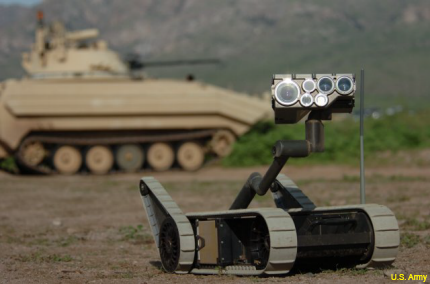Robots to retrieve the wounded from the battlefield
The Army also has other plans for using existing technologies to improve medical care in the trenches.

The Army could one day use ground robots similar to, but larger than, this anti-IED vehicle to retrieve injured troops.
The Army is looking at ways to make more use of robots and other existing technologies to improve medical response on the battlefield, in ways that would not only help injured soldiers but also protect combat medics.
At an Army medical conference earlier this week near the Pentagon, Maj. Gen. Steve Jones, commander of the Army Medical Department Center and School and chief of the Medical Corps, discussed some of the possibilities, according to an Army release.
Robots to the rescue
The Army could adapt some of the ground robots it uses to combat improvised explosive devices to retrieve the wounded. "We already use robots on the battlefield today to examine IEDs, to detonate them," Jones said. "With some minor adaptation, we could take that same technology and use it to extract casualties that are under fire.”
Using robots would also protect medics, who face a heightened risk while trying to rescue a comrade. “How many medics have we lost, or other soldiers, because they have gone in under fire to retrieve a casualty?” he said. “We can use a robotics device for that." Among the changes to the ground robots, he said, could be adding armor that would protect the injured soldier.
UAS for air support
Unmanned aerial systems also could one day be used to retrieve injured soldiers, but they also could supply other types of medical support, including delivering medical supplies to forward deployed units.
The military already has had success using UAS for supply missions, but Jones was talking about a more specific response. "What happens when a member of the team comes down with cellulitis or pneumonia?” he said. While using telemedicine tools to diagnose and treat the patient, UAS also could be used to deliver antibiotics or blood on the spot. "So you don't have to evacuate the casualties, so the team can continue its mission."
Biosensors for triage
Researchers with the Army and other military branches are working now on wearable biosensors that monitor vital signs such as heart rate and perspiration levels, as well as such things as the number of steps taken. Initially intended to identify risk factors and improve performance, Jones said the sensors, which can be monitored remotely, also could be used to expedite triage in the field.
"If you see a casualty whose heart rate is way up, whose respiratory rate is way up, that may be an indication they lost a lot of blood, and need treatment now, as opposed to a casualty whose vital signs are stable and you wouldn't have to treat as quickly," he said, adding that such wearable sensors could be fielded in a couple years.
Putting GoPro to work
A popular and relatively inexpensive commercial technology that could augment telemedicine is a wearable camera such as the GoPro, Jones said. Video from the camera could document a soldier’s wound and the treatment already received, and be transmitted back to doctors who could then advise medics.